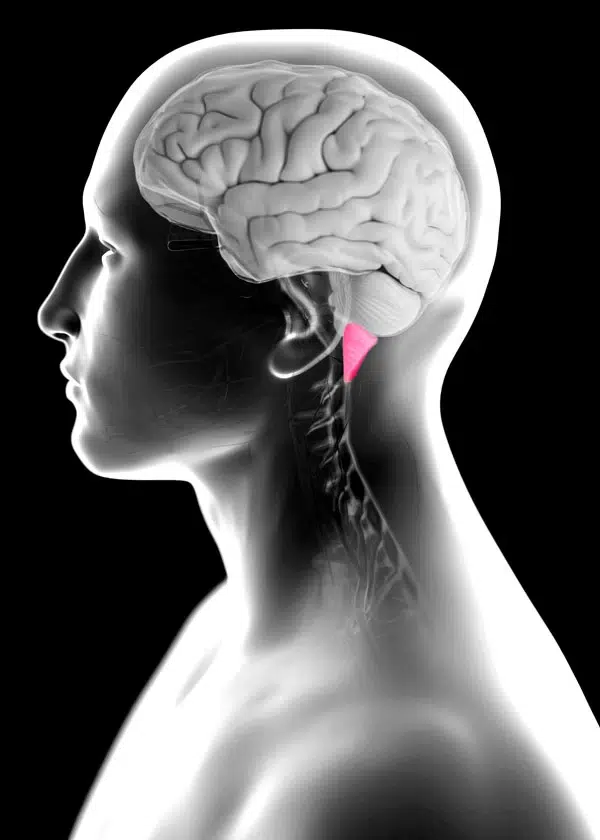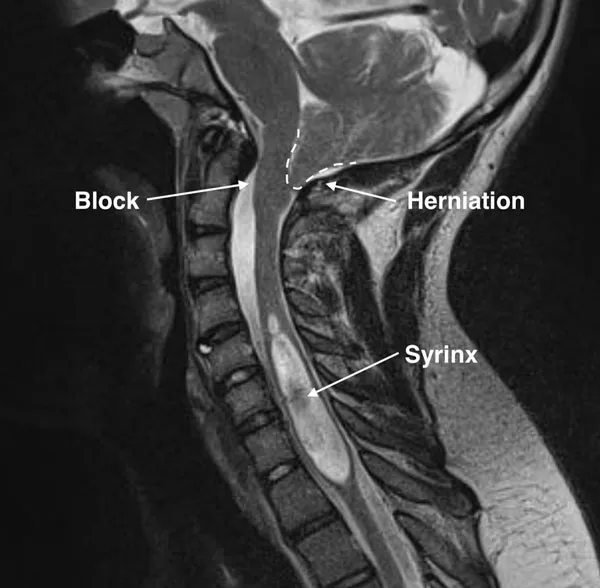What is the Chiari malformation?
Chiari malformation (or Arnold-Chiari malformation) is a group of diseases featured by downward displacement of the cerebellum into the spinal canal. The cerebellum is the part of the brain located in the back part of the head. Together with the brainstem, it occupies a specific nest in the skull called the posterior fossa. The cerebellum is responsible for balance and fine motor coordination. The brainstem is located in the front of the cerebellum and passes through a window in the skull into the spinal canal and continues as the spinal cord. This window is the largest in the skull and is called the foramen Magnum. Under normal conditions, the cerebellum is located above the foramen Magnum. However, in some situations, cerebellar tissue can migrate through the window into the spinal canal. This condition is called Chiari malformation.
How does the Chiari malformation develop?

In the vast majority of cases, Chiari malformation is a congenital disease that develops in the fetus. In this case, the usual cause is a “small posterior fossa”; basically, the volume of the posterior fossa is too small for the cerebellum to fit, and therefore, the tissue has to herniate outside of the posterior fossa.
There are four types of congenital Chiari malformations, with the first two types seen most frequently.
Chiari Malformation Type 1
Type 1 is by far the most common form. Only the lower part of the cerebellum (cerebellar tonsils) migrate into the spinal canal, and there are no other congenital abnormalities.
Chiari Malformation Type 1 (Arnold-Chiari malformation)
Type 2 Chiari malformation is associated with open spinal dysraphism like myelomeningocele. This type is sometimes referred to as Arnold-Chiari malformation.
Rarely, Chiari malformation may develop after birth as a result of cerebrospinal fluid pressure difference between the cranial and spinal compartments. Increased intracranial pressure due to hydrocephalus, idiopathic intracranial hypertension, tumor, etc., may displace the cerebellum toward the spinal canal, causing secondary Chiari malformation. In other cases, the cerebrospinal fluid pressure in the spinal space is decreased (for example, due to a fluid leak or lumbar shunt), which literally “sucks” cerebellar tissue downward.
Chiari malformation may compromise brain and spinal cord functions in several ways. The migrated cerebellar tissue may get compressed by the bone margins of the foramen Magnum and cause cerebellar tissue compromise. The displaced part of the cerebellum may compress and stretch the brainstem and spinal cord as well as the nerves exiting from them. Also, the Chiari malformation causes a “plug” at the foramen Magnum and results in a variety of cerebrospinal fluid circulation abnormalities. The fluid may not be able to exit the brain, leading to hydrocephalus. Also, this blockage may result in syringomyelia – the accumulation of the fluid in the spinal cord tissue.
What are the symptoms of Chiari malformation?
Many people with Chiari have no symptoms at all, and the malformation is discovered accidentally. Others may have symptoms like:
- Headaches, especially in the back of the head. Sometimes, pain may radiate up to the top of the head or down to the shoulders.
- Ataxia or problems with balance and coordination
- Speech and swallowing problems
- Dizziness
- Ringing in the ears
- Muscle weakness
- Numbness in the hands. Usually, when syringomyelia is present
- Vision problems
- Sleep apnea
How is Chiari malformation diagnosed?

The best diagnostic modality for Chiari malformation is the MRI. It has a high sensitivity and specificity for detecting the disease and also shows the presence of associated pathologies like hydrocephalus and syringomyelia. If a cerebrospinal fluid circulation problem is detected or suspected, the physician may request a CSF flow MRI, which is a very specific test designed to demonstrate the fluid flow in the pathological area.
In some cases, a CT scan may be requested to show the bone structures. CT scan demonstrate bone anomalies much better than an MRI. Therefore, the treating physician may request a CT scan if a cranio-cervical junction anomaly is suspected.
What is the treatment for Chiari malformation?
If Chiari malformation is asymptomatic, i.e., causes no symptoms and doesn’t interfere with daily activities, no treatment is necessary. In mild cases, medications can be used to manage symptoms like pain.
Prior to surgical treatment, it is very important to diagnose the cause of Chiari malformation, i.e., whether it is congenital or secondary. Eliminating the cause of disease in secondary Chiari will effectively cure the disease. However, in the vast majority of cases, the Chiari malformation is congenital and treated with surgery.
Foramen Magnum Decompression
Foramen Magnum Decompression (FMD) is the only treatment that can correct functional defects and stop the progression of central nervous system damage. The goals of the surgery are:
Reduce pressure on the cerebellum, brainstem, and spinal cord.
Re-establish normal fluid circulation through and around the compressed area.
Chiari Malformation Surgery: How it is Performed
During the surgery, which is performed by a neurosurgeon, a portion of the occipital bone is removed, and the outer brain covering (dura) is enlarged by placing a soft tissue patch. The purpose is to enlarge the foramen Magnum, eliminate the pressure from the cerebellum and brainstem, and allow them to freely reside in the posterior fossa with no compression. In some cases, the surgeon may coagulate and shrink the dysfunctional cerebellar tonsils to lift the pressure from the brainstem. This procedure effectively eliminates cerebrospinal fluid block, which is the main pathophysiological component. The effective treatment requires adequate surgical decompression.
In some cases, the amount of removed bone is not sufficient, and/or the patch is not used. In these cases, the symptoms may persist following the surgery, and additional operation may be required. In other cases, the decompression may be too extensive, resulting in loss of support for cerebellar tissue and further downward displacement. These cases may need reconstruction of the defect with bone or artificial materials.
Chiari Malformation and Hydrocephalus
Chiari malformation associated with hydrocephalus requires specific treatment. Since hydrocephalus may aggravate the malformation, it should be treated prior to foramen magnum decompression. In some cases, treating hydrocephalus will eliminate cerebellar herniation, and no further treatment will be required.
Chiari Malformation and Syringomyelia
Syringomyelia associated with Chiari malformation is initially managed with FMD. Effective surgical decompression re-establishes normal CSF circulation, and the syringomyelia subsides on its own. However, in rare cases, syringomyelia may persist even after adequate FMD, requiring additional shunt procedures.
